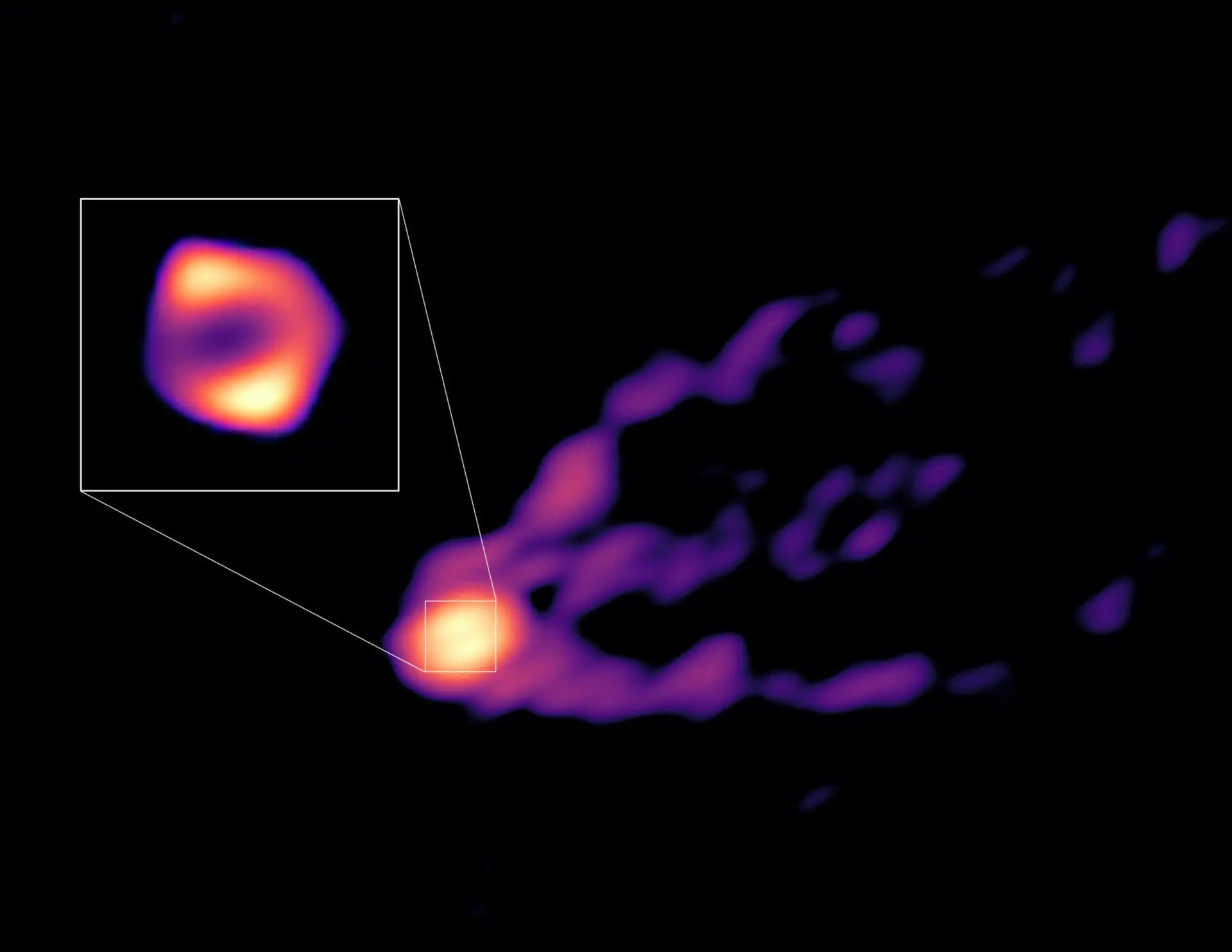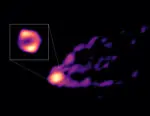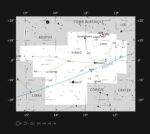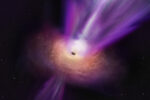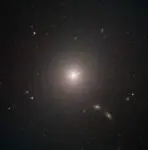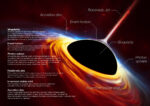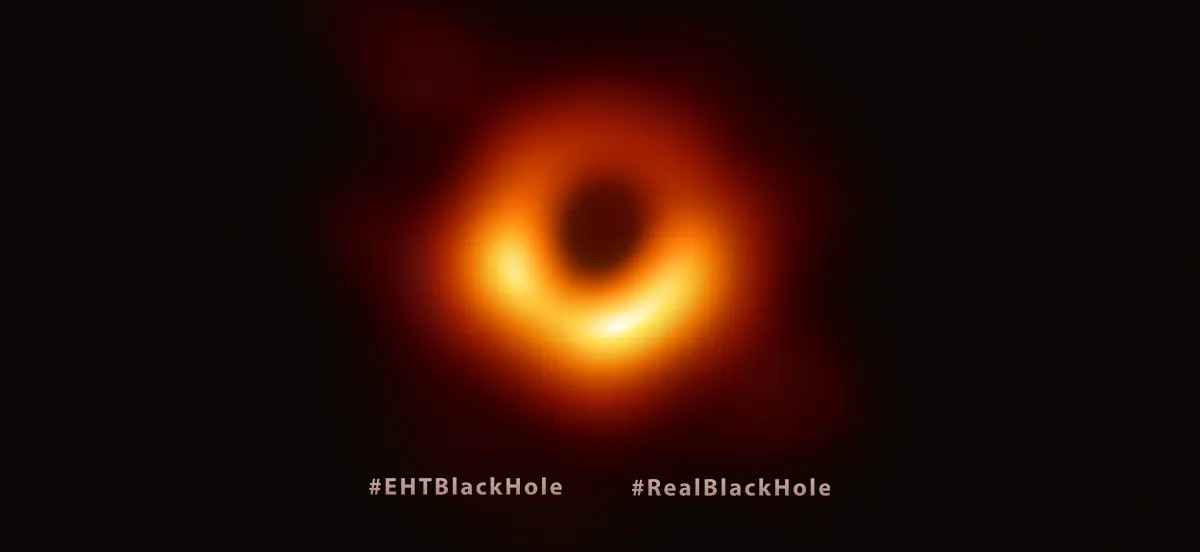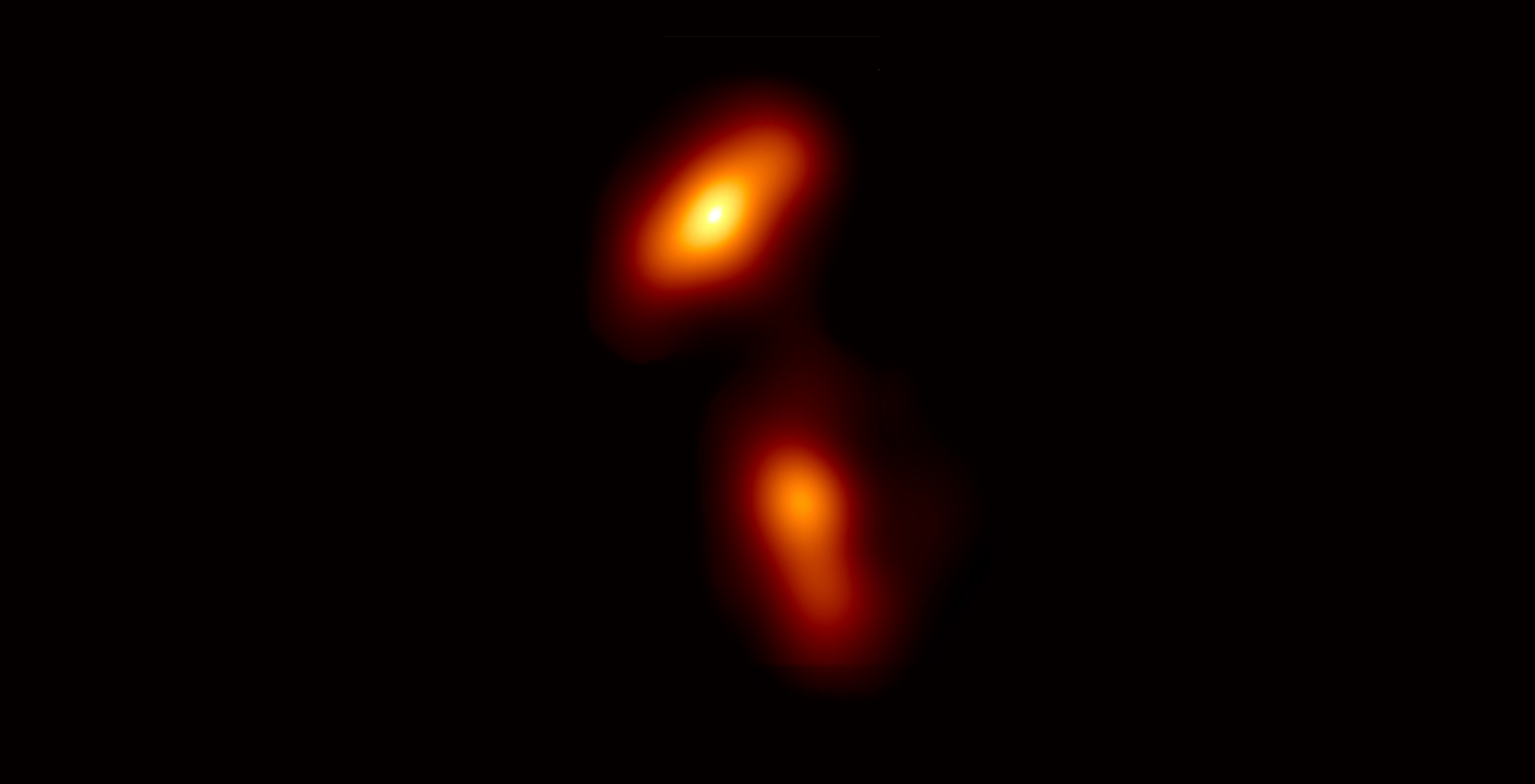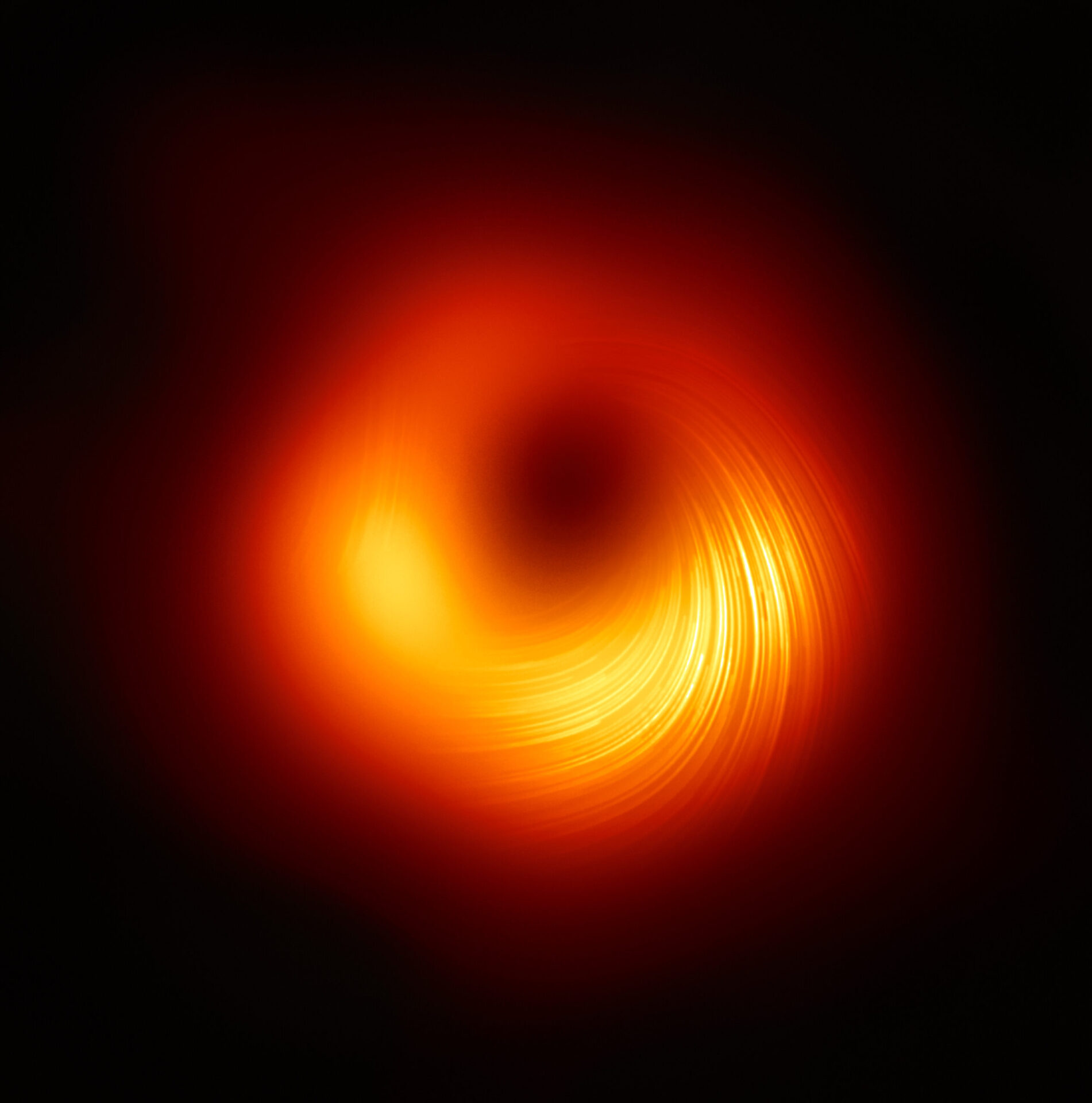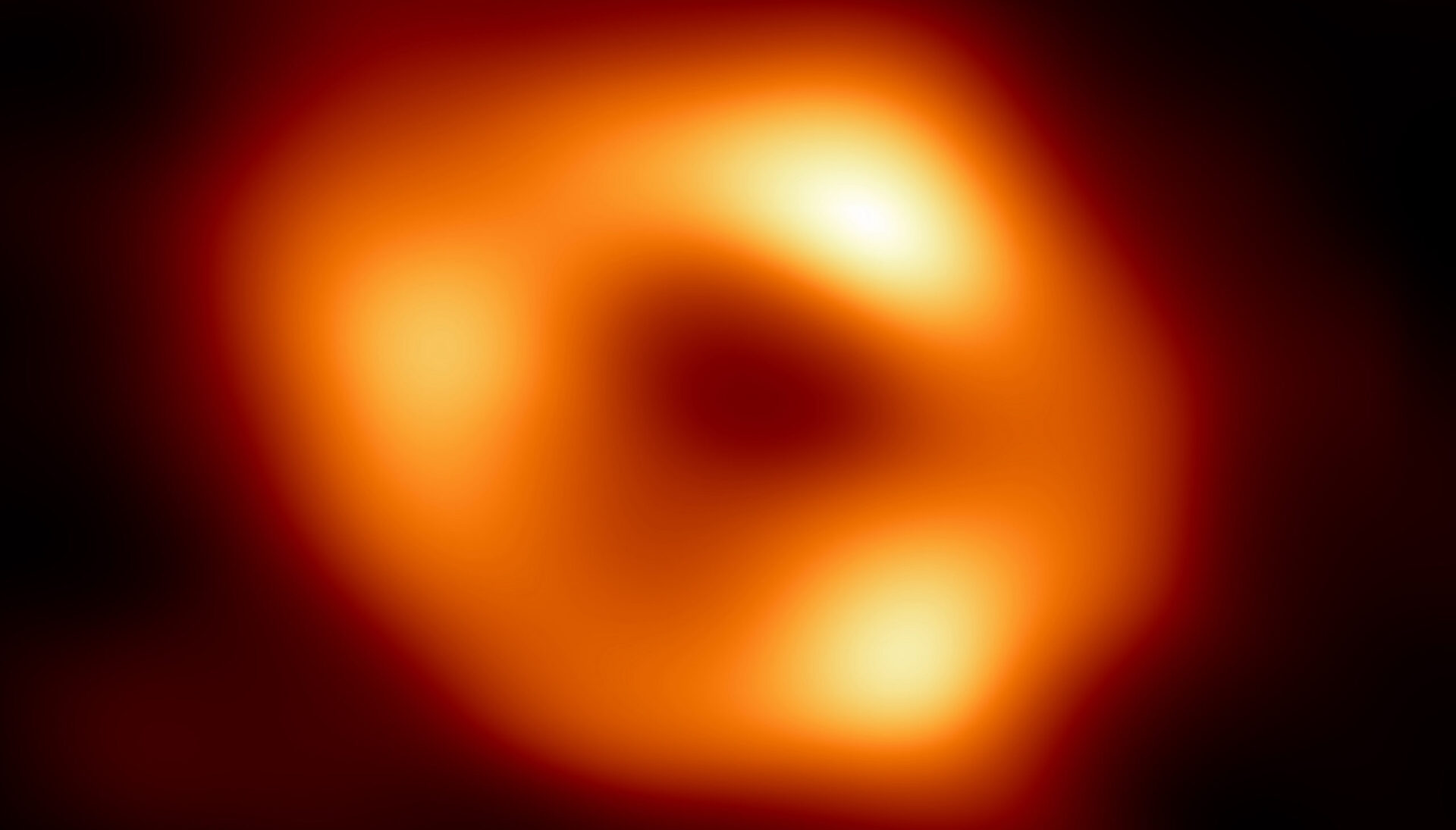Astronomers image for the first time a black hole’s shadow together with a powerful jet
For the first time, astronomers have observed, in the same image, the shadow of the black hole at the center of the galaxy Messier 87 (M87) and the powerful jet expelled from it. The observations were done in 2018 with telescopes from the Global Millimeter VLBI Array (GMVA), the Atacama Large Millimeter/submillimeter Array (ALMA), and the Greenland Telescope (GLT). Thanks to this new image, astronomers can better understand how black holes can launch such energetic jets.
"Previously we had seen both the black hole and the jet in separate images, but now we have taken a panoramic picture of the black hole together with its jet at a new wavelength”, says Ru-Sen Lu, from the Shanghai Astronomical Observatory and leader of a Max Planck Research Group at the Chinese Academy of Sciences. The surrounding material is thought to fall into the black hole in a process known as accretion. But no one has ever imaged it directly. "The ring that we have seen before is becoming larger and thicker at 3.5 mm observing wavelength. This shows that the material falling into the black hole produces additional emission that is now observed in the new image. This gives us a more complete view of the physical processes acting near the black hole”, he added.
The participation of ALMA and GLT in the GMVA observations and the resulting increase in resolution and sensitivity of this intercontinental network of telescopes has made it possible to image the ring-like structure in M87 for the first time at the wavelength of 3.5 mm. The diameter of the ring measured by the GMVA is 64 microarcseconds, which corresponds to the size of a small (5-inch/13-cm) selfie ring light as seen by an astronaut on the Moon looking back at Earth. This diameter is 50 percent larger than what was seen in observations by the Event Horizon Telescope at 1.3 mm, in accordance with the expectations for the emission from relativistic plasma in this region.
"With the greatly improved imaging capabilities by adding ALMA and GLT into GMVA observations, we have gained a new perspective. We do indeed see the triple-ridged jet that we knew about from earlier VLBI observations,” says Thomas Krichbaum from the Max Planck Institute for Radio Astronomy (MPIfR) in Bonn. "But now we can see how the jet emerges from the emission ring around the central supermassive black hole and we can measure the ring diameter also at another (longer) wavelength.”
"ALMA has once again showed to be a key player in mm-VLBI observations. Its size and geographical location have teamed with GMVA stations around the world to provide for the first time a glimpse of the jet and accretion flow in M87 in a single image" explains Hugo Messias, Lead Astronomer for VLBI observations at ALMA and coauthor of this research. "This has tremendous implications to our knowledge since the obtained information is more than just an image. It also allows us to infer the rate at which the black hole is growing and where the jet comes from. Nevertheless, other cases need to be observed and studied in order to obtain statistically representative conclusions about black holes and jets, hence the need for the yearly VLBI observations that ALMA joins."
The light from M87 is produced by the interplay between highly energetic electrons and magnetic fields, a phenomenon called synchrotron radiation. The new observations, at a wavelength of 3.5 mm, reveal more details about the location and energy of these electrons. They also tell us something about the nature of the black hole itself: it is not very hungry. It consumes matter at a low rate, converting only a small fraction of it into radiation. Keiichi Asada of Academia Sinica, Institute of Astronomy and Astrophysics explains: "To understand the physical origin of the bigger and thicker ring, we had to use computer simulations to test different scenarios. As a result, we concluded that the larger extent of the ring is associated with the accretion flow.”
Kazuhiro Hada from the National Astronomical Observatory of Japan adds: "We also find something surprising in our data: the radiation from the inner region close to the black hole is broader than we expected. This could mean that there is more than just gas falling in. There could also be a wind blowing out, causing turbulence and chaos around the black hole.”
The quest to learn more about M87 is not over, as further observations and a fleet of powerful telescopes continue to unlock its secrets. “Future observations at millimetre wavelengths will study the time evolution of the M87 black hole and provide a poly-chromatic view of the black hole with multiple color images in radio light," says Jongho Park of the Korea Astronomy and Space Science Institute.
ALMA is participating in a new VLBI observation campaign from April 12 to May 10, 2023 to further study M87 and other sources.
Additional Information
This research was presented in the paper "A ring-like accretion structure in M87 connecting its black hole and jet" to appear in Nature (doi: 10.1038/s41586-023-05843-w).
The team is composed of Ru-Sen Lu (Shanghai Astronomical Observatory, People’s Republic of China [Shanghai]; Key Laboratory of Radio Astronomy, People’s Republic of China [KLoRA]; Max-Planck-Institut für Radioastronomie, Germany [MPIfR]), Keiichi Asada (Institute of Astronomy and Astrophysics, Academia Sinica, Taiwan, ROC [IoAaA]), Thomas P. Krichbaum (MPIfR), Jongho Park (IoAaA; Korea Astronomy and Space Science Institute, Republic of Korea [KAaSSI]), Fumie Tazaki (Simulation Technology Development Department, Tokyo Electron Technology Solutions Ltd., Japan; Mizusawa VLBI Observatory, National Astronomical Observatory of Japan, Japan [Mizusawa]), Hung-Yi Pu (Department of Physics, National Taiwan Normal University, Taiwan, ROC; IoAaA; Center of Astronomy and Gravitation, National Taiwan Normal University, Taiwan, ROC), Masanori Nakamura (National Institute of Technology, Hachinohe College, Japan; IoAaA), Andrei Lobanov (MPIfR), Kazuhiro Hada (Mizusawa; Department of Astronomical Science, The Graduate University for Advanced Studies, Japan), Kazunori Akiyama (Black Hole Initiative at Harvard University, USA; Massachusetts Institute of Technology Haystack Observatory, USA [Haystack]; National Astronomical Observatory of Japan, Japan [NAOoJ]), Jae-Young Kim (Department of Astronomy and Atmospheric Sciences, Kyungpook National University, Republic of Korea; KAaSSI; MPIfR), Ivan Marti-Vidal (Departament d’Astronomia i Astrofísica, Universitat de València, Spain; Observatori Astronòmic, Universitat de València, Spain), Jose L. Gomez (Instituto de Astrofísica de Andalucía-CSIC, Spain [IAA]), Tomohisa Kawashima (Institute for Cosmic Ray Research, The University of Tokyo, Japan), Feng Yuan (Shanghai; Key Laboratory for Research in Galaxies and Cosmology, Chinese Academy of Sciences, People’s Republic of China; School of Astronomy and Space Sciences, University of Chinese Academy of Sciences, People’s Republic of China [SoAaSS]), Eduardo Ros (MPIfR), Walter Alef (MPIfR), Silke Britzen (MPIfR), Michael Bremer (Institut de Radioastronomie Millimétrique, France [IRAMF]), Avery E. Broderick (Department of Physics and Astronomy, University of Waterloo, Canada [Waterloo]; Waterloo Centre for Astrophysics, University of Waterloo, Canada; Perimeter Institute for Theoretical Physics, Canada), Akihiro Doi (The Institute of Space and Astronautical Science, Japan Aerospace Exploration Agency, Japan; Department of Space and Astronautical Science, SOKENDAI, Japan [SOKENDAI]), Gabriele Giovannini (Dipartimento di Fisica e Astronomia, Università di Bologna, Italy; Istituto di Radio Astronomia, INAF, Bologna, Italy [INAF]), Marcello Giroletti (INAF), Paul T. P. Ho (IoAaA), Mareki Honma (Mizusawa; Hachinohe; Department of Astronomy, The University of Tokyo, Japan), David H. Hughes (Instituto Nacional de Astrofísica, Mexico), Makoto Inoue (IoAaA), Wu Jiang (Shanghai), Motoki Kino (NAOoJ; Kogakuin University of Technology and Engineering, Japan), Shoko Koyama (Niigata University, Japan; IoAaA), Michael Lindqvist (Department of Space, Earth and Environment, Chalmers University of Technology, Sweden [Chalmers]), Jun Liu (MPIfR), Alan P. Marscher (Institute for Astrophysical Research, Boston University, USA), Satoki Matsushita (IoAaA), Hiroshi Nagai (NAOoJ; SOKENDAI), Helge Rottmann (MPIfR), Tuomas Savolainen (Department of Electronics and Nanoengineering, Aalto University, Finland; Metsähovi Radio Observatory, Finland [Metsähovi]; MPIfR), Karl-Friedrich Schuster (IRAMF), Zhi-Qiang Shen (Shanghai; KLoRA), Pablo de Vicente (Observatorio de Yebes, Spain [Yebes]), R. Craig Walker (National Radio Astronomy Observatory, Socorro, USA), Hai Yang (Shanghai; SoAaSS), J. Anton Zensus (MPIfR), Juan Carlos Algaba (Department of Physics, Universiti Malaya, Malaysia), Alexander Allardi (University of Vermont, USA), Uwe Bach (MPIfR), Ryan Berthold (East Asian Observatory, USA [EAO]), Dan Bintley (EAO), Do-Young Byun (KAaSSI; University of Science and Technology, Daejeon, Republic of Korea), Carolina Casadio (Institute of Astrophysics, Heraklion, Greece; Department of Physics, University of Crete, Greece), Shu-Hao Chang (IoAaA), Chih-Cheng Chang (National Chung-Shan Institute of Science and Technology, Taiwan, ROC [Chung-Shan]), Song-Chu Chang (Chung-Shan), Chung-Chen Chen (IoAaA), Ming-Tang Chen (Institute of Astronomy and Astrophysics, Academia Sinica, USA [IAAAS]), Ryan Chilson (IAAAS), Tim C. Chuter (EAO), John Conway (Chalmers), Geoffrey B. Crew (Haystack), Jessica T. Dempsey (EAO; Astron, The Netherlands [Astron]), Sven Dornbusch (MPIfR), Aaron Faber (Western University, Canada), Per Friberg (EAO), Javier González García (Yebes), Miguel Gómez Garrido (Yebes), Chih-Chiang Han (IoAaA), Kuo-Chang Han (System Development Center, National Chung-Shan Institute of Science and Technology, Taiwan, ROC), Yutaka Hasegawa (Osaka Metropolitan University, Japan [Osaka]), Ruben Herrero-Illana (European Southern Observatory, Chile), Yau-De Huang (IoAaA), Chih-Wei L. Huang (IoAaA), Violette Impellizzeri (Leiden Observatory, the Netherlands; National Radio Astronomy Observatory, Charlottesville, USA [NRAOC]), Homin Jiang (IoAaA), Hao Jinchi (Electronic Systems Research Division, National Chung-Shan Institute of Science and Technology, Taiwan, ROC), Taehyun Jung (KAaSSI), Juha Kallunki (Metsähovi), Petri Kirves (Metsähovi), Kimihiro Kimura (Japan Aerospace Exploration Agency, Japan), Jun Yi Koay (IoAaA), Patrick M. Koch (IoAaA), Carsten Kramer (IRAMF), Alex Kraus (MPIfR), Derek Kubo (IAAAS), Cheng-Yu Kuo (National Sun Yat-Sen University, Taiwan, ROC), Chao-Te Li (IoAaA), Lupin Chun-Che Lin (Department of Physics, National Cheng Kung University, Taiwan, ROC ), Ching-Tang Liu (IoAaA), Kuan-Yu Liu (IoAaA), Wen-Ping Lo (Department of Physics, National Taiwan University, Taiwan, ROC; IoAaA), Li-Ming Lu (Chung-Shan), Nicholas MacDonald (MPIfR), Pierre Martin-Cocher (IoAaA), Hugo Messias (Joint ALMA Observatory, Chile; Osaka), Zheng Meyer-Zhao (Astron; IoAaA), Anthony Minter (Green Bank Observatory, USA), Dhanya G. Nair (Astronomy Department, Universidad de Concepción, Chile), Hiroaki Nishioka (IoAaA), Timothy J. Norton (Center for Astrophysics | Harvard & Smithsonian, USA [CfA]), George Nystrom (IAAAS), Hideo Ogawa (Osaka), Peter Oshiro (IAAAS), Nimesh A. Patel (CfA), Ue-Li Pen (IoAaA), Yurii Pidopryhora (MPIfR; Argelander-Institut für Astronomie, Universität Bonn, Germany), Nicolas Pradel (IoAaA), Philippe A. Raffin (IAAAS), Ramprasad Rao (CfA), Ignacio Ruiz (Institut de Radioastronomie Millimétrique, Granada, Spain [IRAMS]), Salvador Sanchez (IRAMS), Paul Shaw (IoAaA), William Snow (IAAAS), T. K. Sridharan (NRAOC; CfA), Ranjani Srinivasan (CfA; IoAaA), Belén Tercero (Yebes), Pablo Torne (IRAMS), Thalia Traianou (IAA; MPIfR), Jan Wagner (MPIfR), Craig Walther (EAO), Ta-Shun Wei (IoAaA), Jun Yang (Chalmers), Chen-Yu Yu (IoAaA).
This research has made use of data obtained with the Global Millimeter VLBI Array (GMVA), which consists of telescopes operated by the Max-Planck-Institut für Radioastronomie (MPIfR), Institut de Radioastronomie Millimétrique (IRAM), Onsala Space Observatory (OSO), Metsähovi Radio Observatory (MRO), Yebes, the Korean VLBI Network (KVN), the Green Bank Telescope (GBT) and the Very Long Baseline Array (VLBA).
The Atacama Large Millimeter/submillimeter Array (ALMA), an international astronomy facility, is a partnership of the European Organisation for Astronomical Research in the Southern Hemisphere (ESO), the U.S. National Science Foundation (NSF) and the National Institutes of Natural Sciences (NINS) of Japan in cooperation with the Republic of Chile. ALMA is funded by ESO on behalf of its Member States, by NSF in cooperation with the National Research Council of Canada (NRC) and the National Science and Technology Council (NSTC) in Taiwan and by NINS in cooperation with the Academia Sinica (AS) in Taiwan and the Korea Astronomy and Space Science Institute (KASI).
ALMA construction and operations are led by ESO on behalf of its Member States; by the National Radio Astronomy Observatory (NRAO), managed by Associated Universities, Inc. (AUI), on behalf of North America; and by the National Astronomical Observatory of Japan (NAOJ) on behalf of East Asia. The Joint ALMA Observatory (JAO) provides the unified leadership and management of the construction, commissioning and operation of ALMA.
The Greenland Telescope (GLT) retrofit, rebuild, and operation are led by the Academia Sinica, Institute of Astronomy and Astrophysics (ASIAA) and the Smithsonian Astrophysical Observatory (SAO).
Images
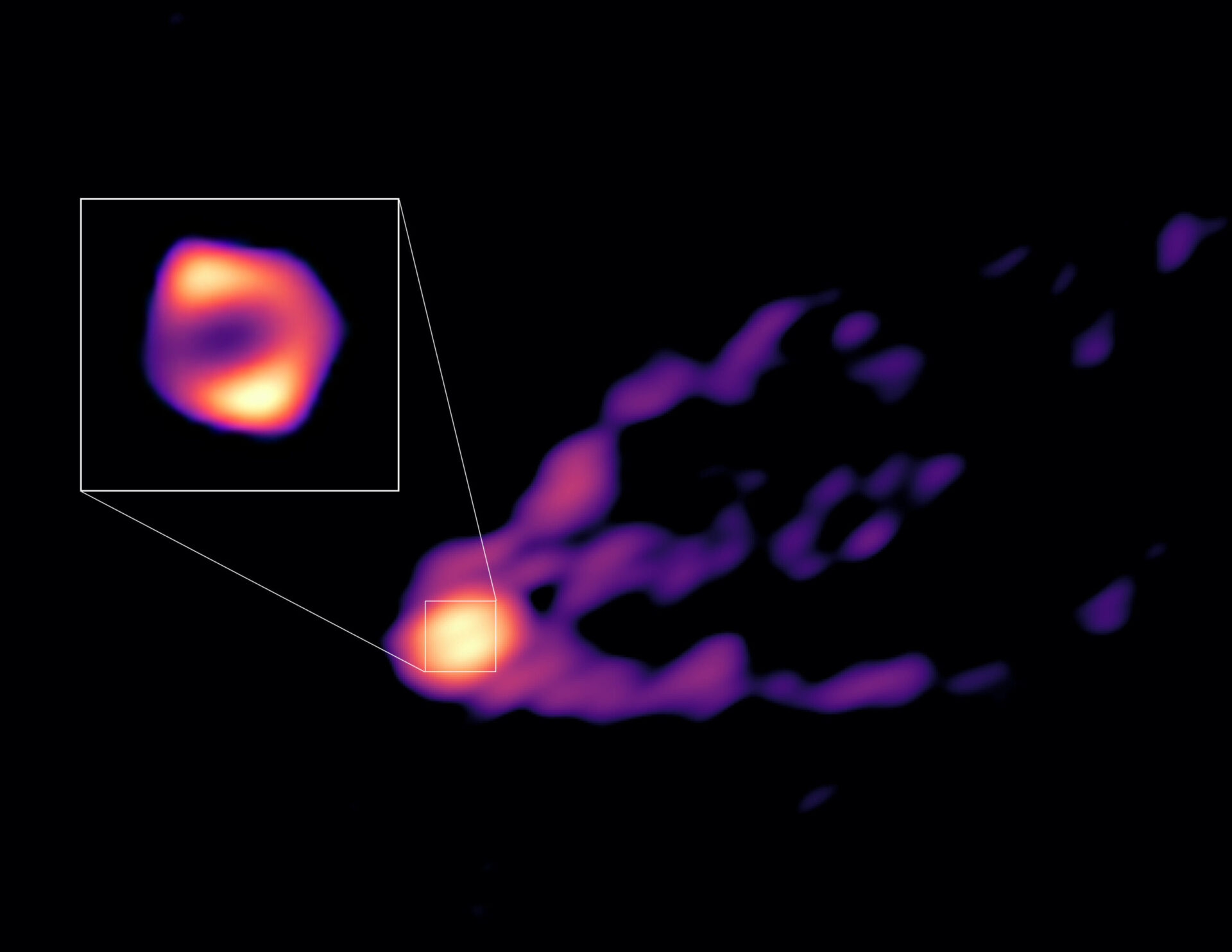
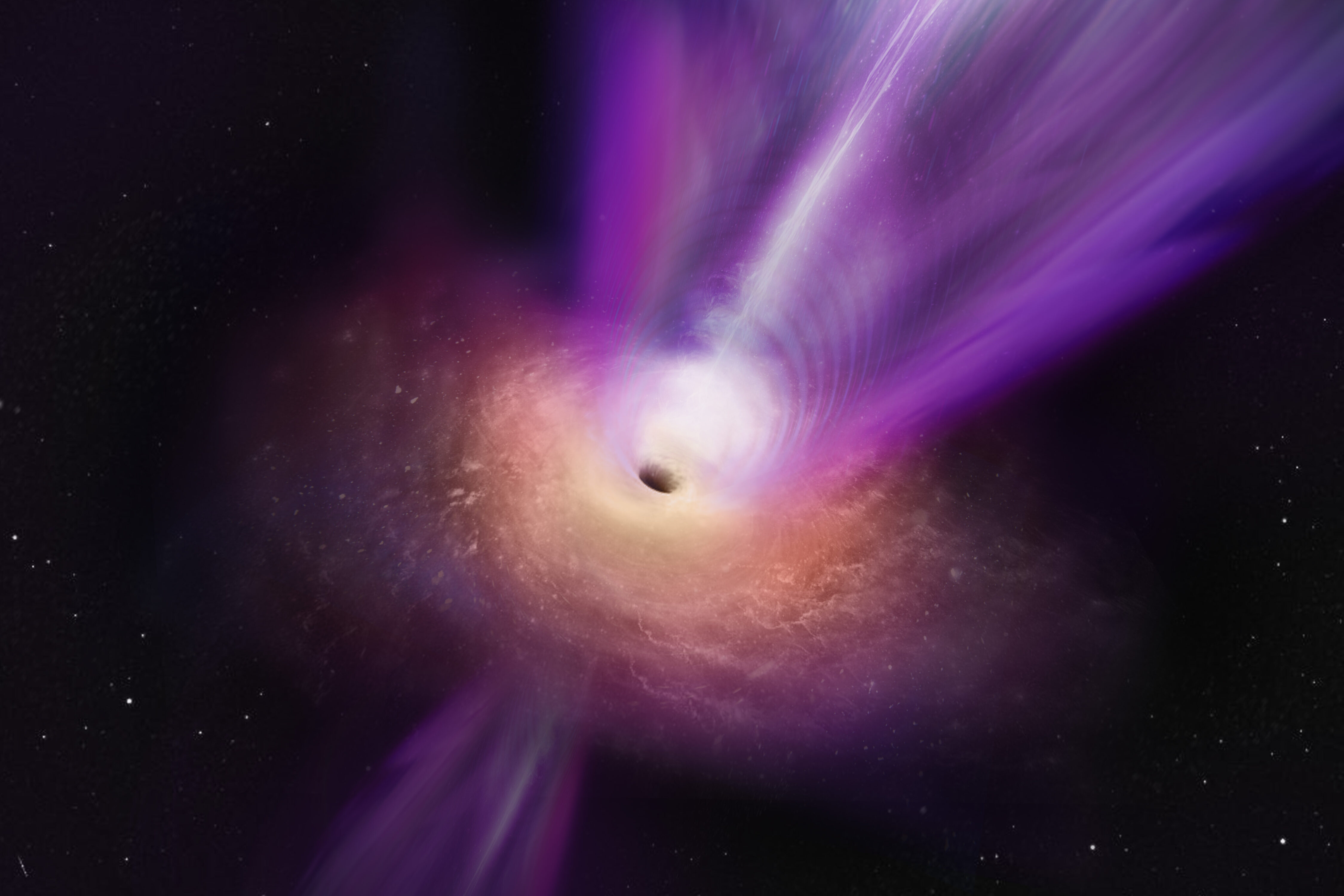
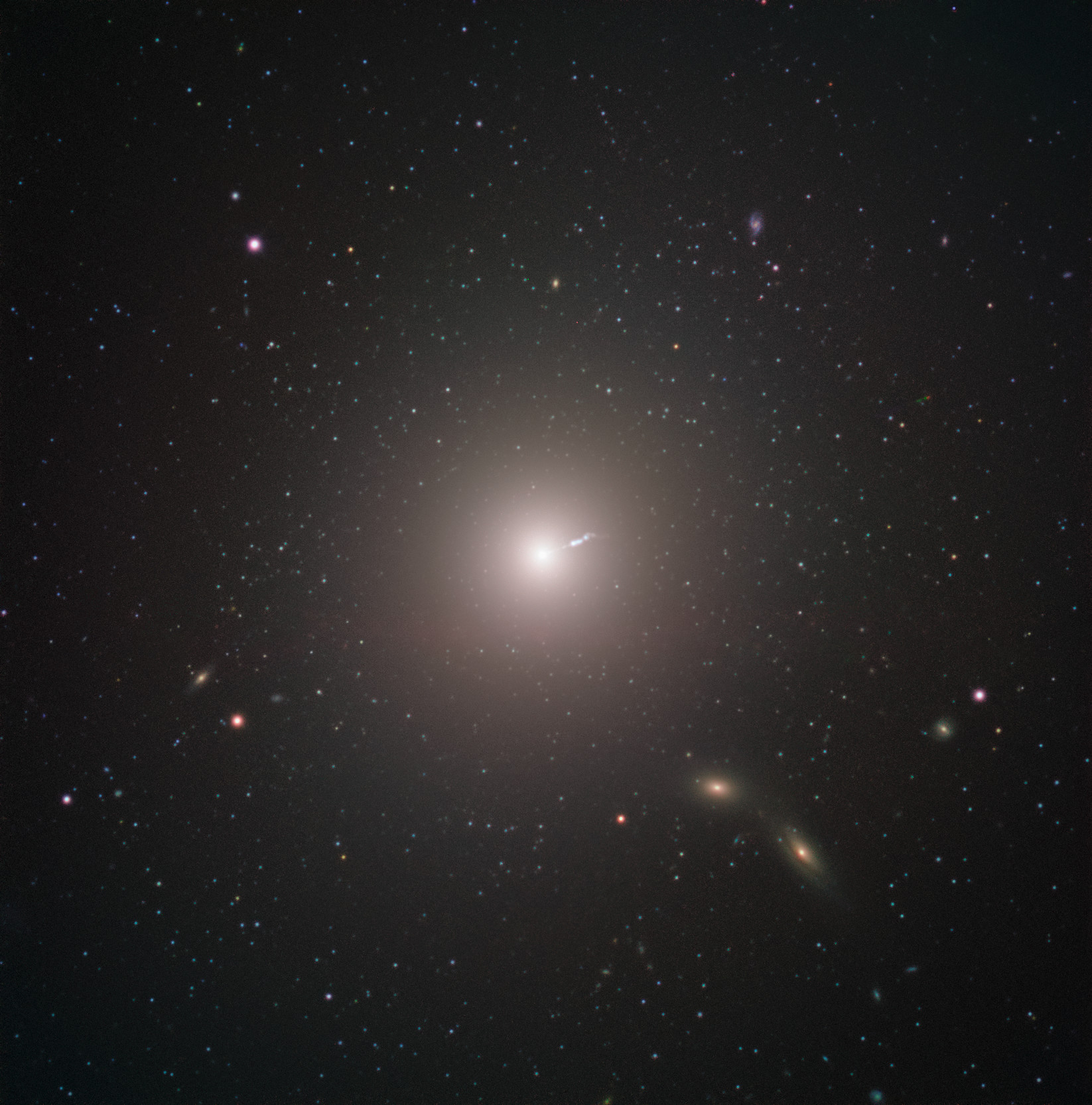
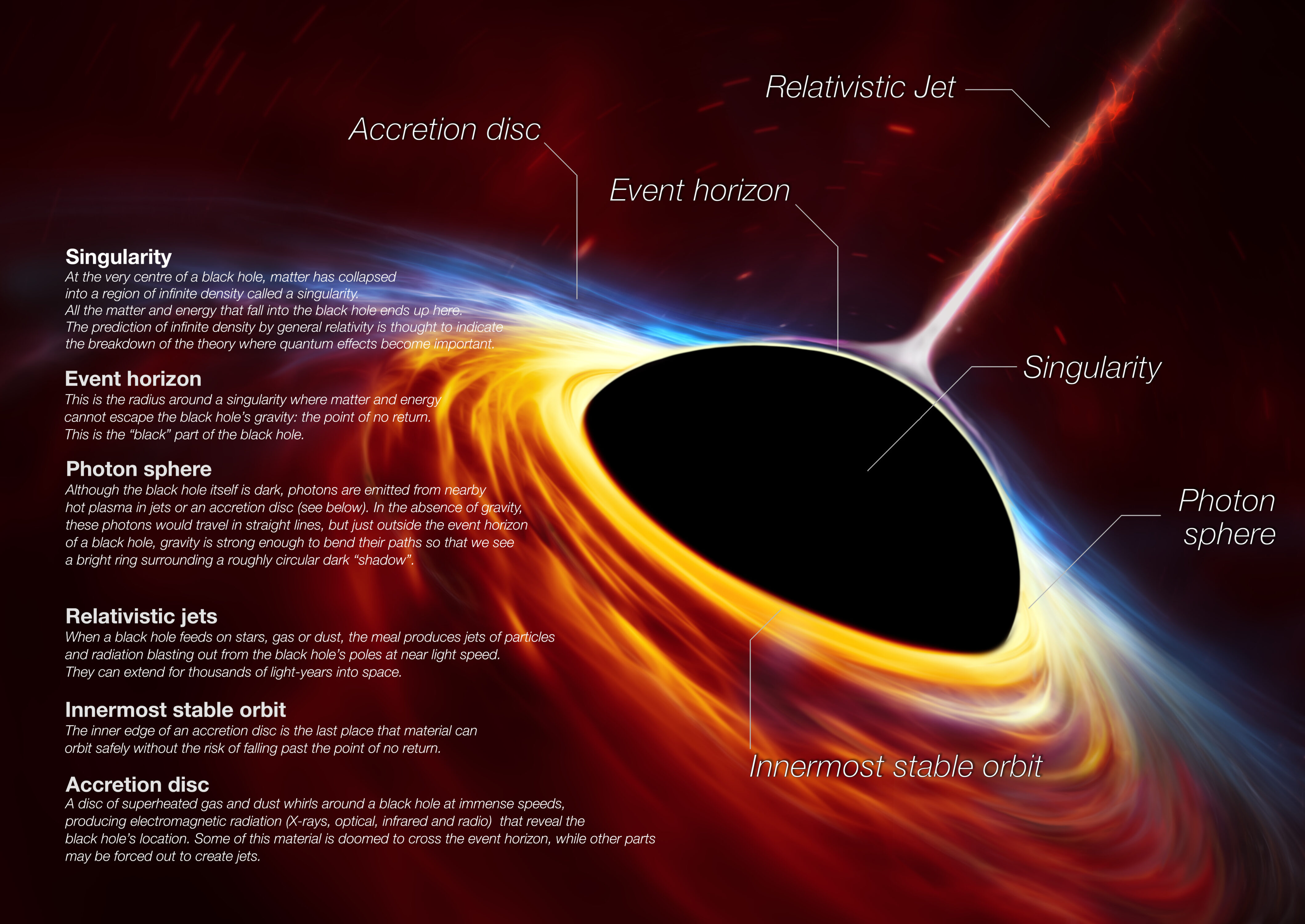
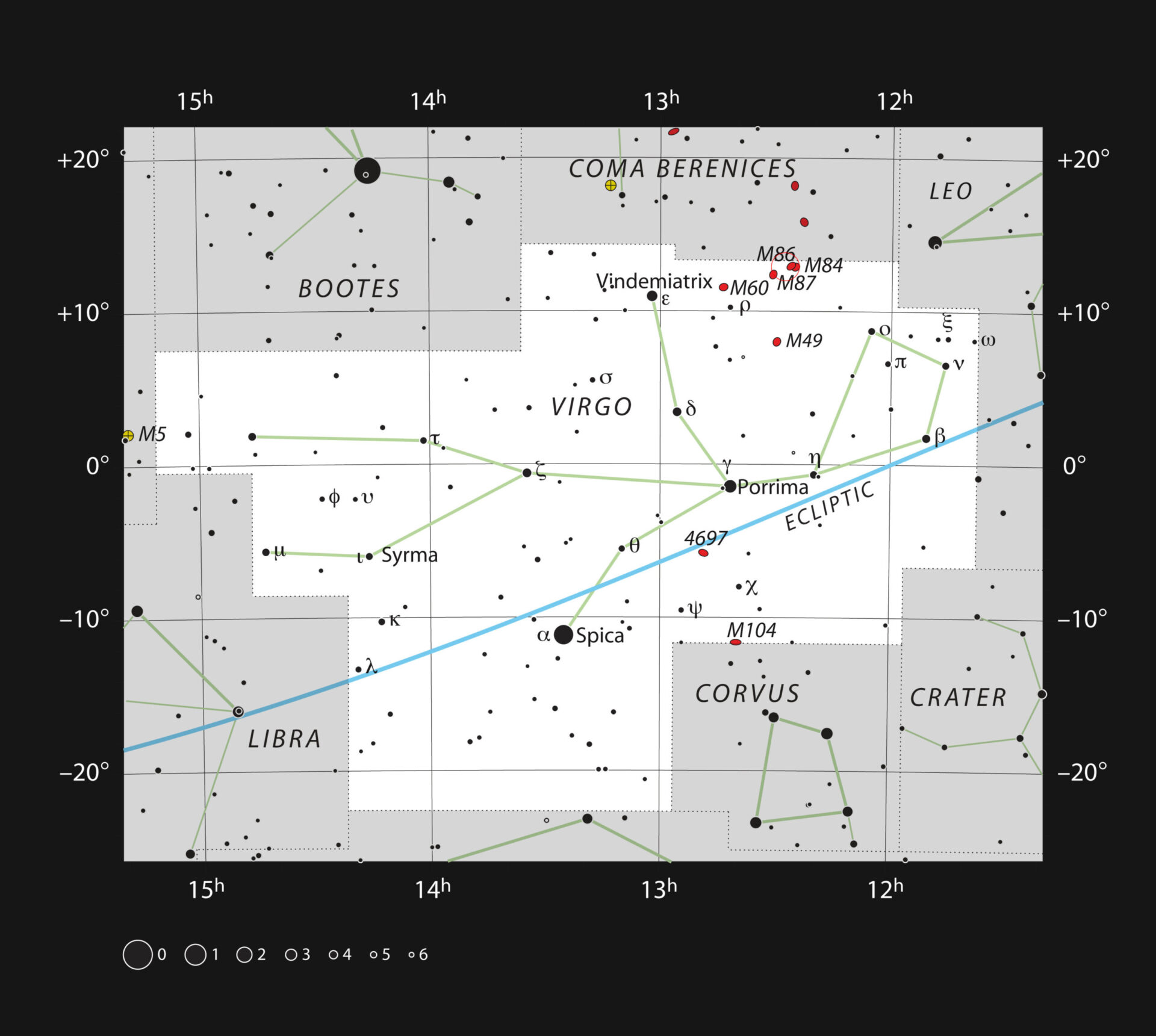
Contacts
-
Naoko Inoue
EPO officer, ALMA ProjectNational Astronomical Observatory of Japan (NAOJ)Email: [email protected] -
Juan Carlos Muñoz Mateos
ESO Media Officer -
Amy C. Oliver
Public Information & News Manager
